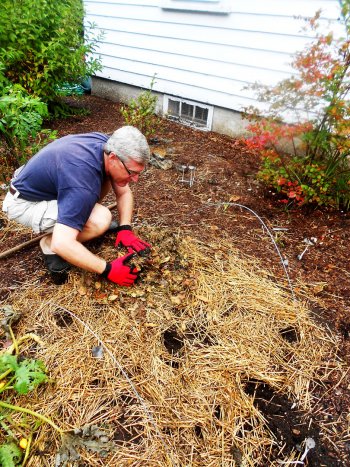We've reached the time in the growing season when the majority of our vegetables have been harvested. The only vegetables remaining in the garden are the hardiest, which actually improve in taste after a few frosts. Examples include Brussels sprouts, kale and broccoli; continue to harvest them through Thanksgiving. If you planted garlic bulbs for harvest next summer, don't touch that area of the garden (except for covering with straw to protect against erosion and insulate the soil). Parsnips can be left alone over the entire winter for harvest early next spring.
The remainder of the garden is ready to go to bed for the winter. There are three steps you should take to prepare for the upcoming cold weather and have your garden ready to go to work for you early next spring: Clip and clear out stems and leaves, but keep stubble and the roots intact; remove and store garden tools and fixtures; and thoroughly cover your garden with mulch.
After you've harvested the last vegetables from your garden, neatly clip and trim off the remaining stems, leaving the root structure untouched. Whatever you cut away can be placed in your compost pile for next year; just watch for any diseased matter (if it contacts your compost, it may lead to more disease next year).
The leftover stubble (maybe an inch tall or so above the ground) prevents soil erosion plus provides food and air passages for microbes and worms. Those microbes and worms in the soil will continue to work over the winter, breaking down roots and enriching the soil for next spring.
Second, remove and store all of your garden tools and fixtures (such as stepping stones, plastic sheeting and stakes). If you choose to rototill your garden next spring, removing all inert items from your garden now prevents potentially chopping up those that buried themselves over the winter.
Neatly stacking stones and stakes, and rolling up (and lashing) sheeting gives your garden an organized appearance and facilitates quickly finding and resetting all of those items next spring. Metal tools should be washed down and brought inside your garage or storage shed, where they will not rust over the winter months.
Finally, and by far most important, you should place a very thick layer (at least four inches) of finely-chopped leaf mulch on top of your garden. This mulch will insulate your soil, allowing those microbes and worms to continue their critical work chewing roots, soil, and even the bottom half of the mulch. Another wonderful benefit of mulching now is that next spring you will have a matting of decayed leaves covering the entire bed, which will discourage weed growth.
When you're planting seeds and seedlings next spring, you can dig through the mulch, place the seeds or seedlings at their proper depth, add compost to level off with the surrounding surface, and leave the rest of the mulch untouched. You'll get a head start on those vegetables developing before weeds begin poking through. Since those weeds have worked so hard to get to the surface, they will be weak and easy to hand pick.
Here's an easy method for creating your own leaf mulch. As the leaves fall on your lawn (or a friendly neighbor's lawn), rake them into large piles, either on the lawn, a sidewalk, or the shoulder of your street. If you have a mulching lawn mower, run the mower over and through the pile of leaves until the leaves are chopped into ½-inch to 1-inch pieces. It's important to have small chips, to increase the surface area and provide lots of air and moisture spaces between them. Once the leaves are finely chopped, gather them onto a tarp, drag the tarp to a section of your garden bed, and flip over the tarp. Use a rake to level off the top surface.
If you don't have a mulching mower, you can still chop through the leaves and bag the chips. You may need to dump the contents of the bag to cut through the leaves a second time.
Properly putting your garden to bed this fall can result in a mixture of feelings. You're sad to see the 2012 growing season end, but you're happy to be laying the groundwork for an even more successful 2013 growing season. Over the winter months, think about what worked well this year (maybe a combination of vegetables planted as companions, beneficial flowers that brought pollinators to your garden, or a watering/fertilizing routine that brought you a large harvest), and also what didn't work so well. Keep notes and sketches/pictures of both the successes and failures from 2012.
When those seed catalogs arrive in the middle of winter, you'll recall what happened this past year and determine how you'll make improvements for 2013.
Scott Morrison gardens at the Concord Community Garden and at his home in the South End. He is president of the Northeast Organic Farming Association of New Hampshire and vice president of the Capital Area Organic Gardeners.
To share gardening tips with Concord's most passionate gardeners, join the Capital Area Organic Gardeners on Oct. 17 at 6 p.m. for a harvest potluck followed by “The Thrill of Victory and the Agony of Defeat,” and be ready to share your own garden stories. For more information, visit ccognh.wordpress.com.






















